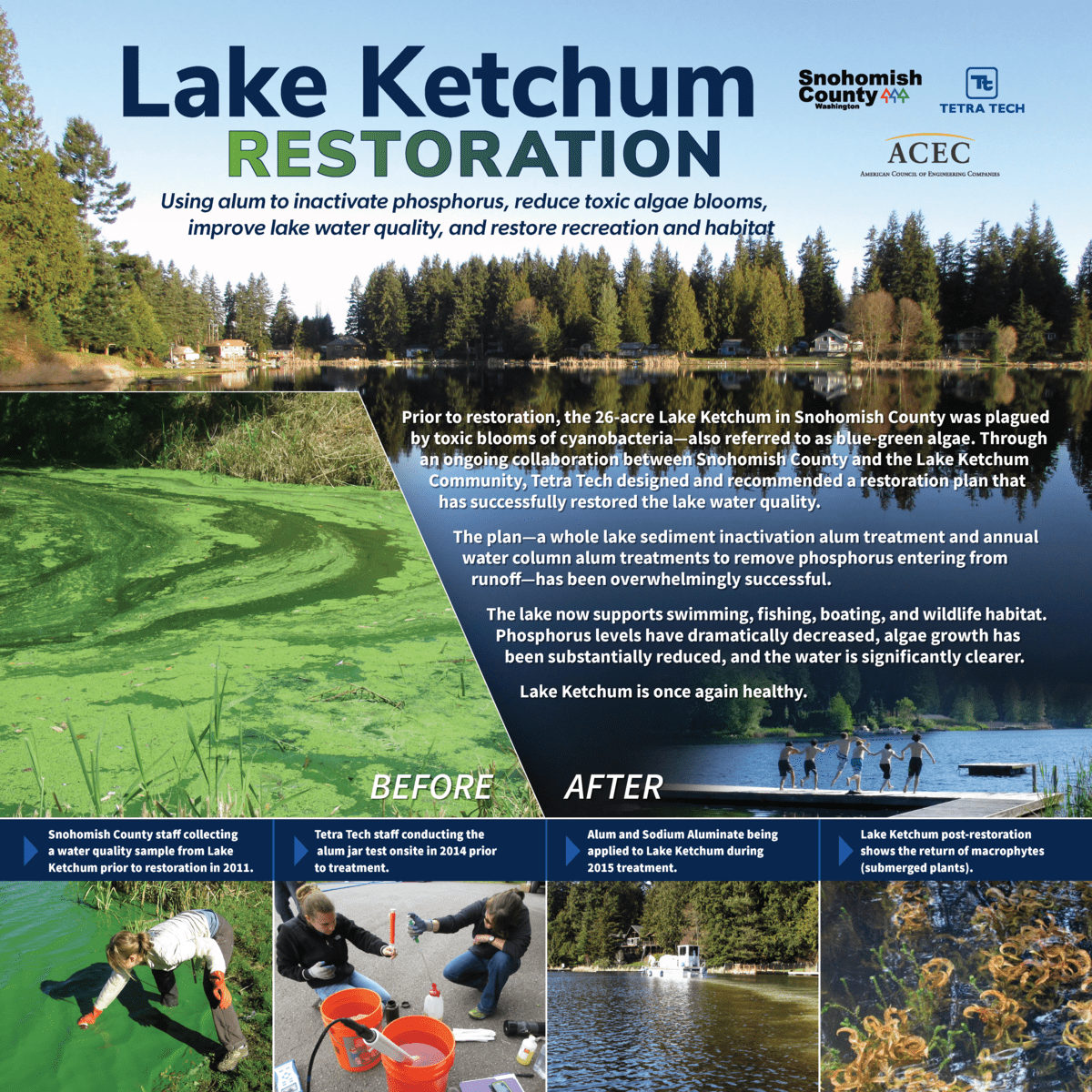April 18, 2022
Designing a Better World: Tetra Tech’s Lake Ketchum Restoration Project


This week on the Last Word blog, we’re celebrating Earth Day by shining a spotlight on project examples of how ACEC member firms are helping the #Designabetterworld. Our first example is from Tetra Tech, and their award-winning Lake Ketchum Restoration project in Snohomish County, Washington.
Project Description:
Lake Ketchum, a 26-acre lake in northwest Snohomish County, supports swimming, fishing, boating, aesthetic enjoyment, and wildlife habitat. Until the 1940s, the Lake Ketchum watershed, the areas that drain into the lake, was largely undeveloped and the lake served as a drinking water source for the City of Stanwood. Since that time, the water quality of the lake markedly deteriorated and, prior to restoration, LakeKetchum was the most polluted water body in Snohomish County and one of the worst in the state.
Prior to restoration, Lake Ketchum was plagued by toxic blooms of cyanobacteria, also referred to as blue-green algae. These thick growths of algae formed unsightly scums on the lake surface that severely impaired the use and enjoyment of the lake. The algae blooms were also frequently toxic, which threatened the health of people and pets that used the lake and forced the lake to be closed or restricted for use by the community. The harmful algae blooms were caused by extremely high levels of phosphorus in the lake.
The original source of the phosphorus pollution in the lake was a former dairy farm, and, over time, phosphorus entering the lake from the farm accumulated at the lake bottom and became the major source of pollution to the lake.
Through ongoing collaboration between Snohomish County and the Lake Ketchum community, the lake water quality has been successfully restored. In 2010, Snohomish County initiated a project to work toward a feasible restoration plan for Lake Ketchum. Snohomish County was awarded a grant from the Department of ecology to fund a lake study to identify the best methods of reducing phosphorus and controlling future blooms of algae.
The Solution:
Tetra Tech assisted Snohomish County with the development of an algae control plan by developing a phosphorus mass balance model and evaluating several lake restoration methods to identify the most feasible and effective actions to reduce phosphorus. Tetra Tech designed and recommended a restoration plan that included a whole lake sediment inactivation alum treatment to inactivate legacy phosphorus in the sediments. The plan, which mostly eliminated internal phosphorus loading, was combined with annual water column alum treatments to remove phosphorus entering the lake each year from external sources. The annual application of alum, with the goal to treat continual external loading, was an innovative and unique solution utilizing a proven technology. Large-scale alum treatments were conducted in 2014 and 2015, and annual water column alum treatments have been conducted each year from 2016 through 2021.
The innovative approach of adding small annual alum treatments has successfully neutralized the continued external phosphorus loading by stripping the phosphorus out of the water column. Phosphorus levels have dramatically decreased in the lake causing substantial reductions in algal growth, significantly clearer water, and higher dissolved oxygen. Most importantly, toxic algal blooms have been virtually eliminated.
The annual water column alum treatments have controlled the continued external loading of phosphorus by stripping the phosphorus out of the water column and have significantly reduced algal blooms. Residents and lake users are now able to enjoy the lake for swimming, fishing, and boating throughout the summer. Phosphorus levels have dramatically decreased in the lake, algae growth has been substantially reduced, and the water is significantly clearer. The large sediment inactivation treatments essentially eliminated phosphorus release from the sediments and there has not been any buildup of phosphorus in the bottom waters of the lake. The treatments reduced bottom water phosphorus by more than 99 percent.
The treatment approach at Lake Ketchum has shown that the successful inactivation of sediment phosphorus using alum is both safe and effective, which advances the positive public image of alum as a lake restoration strategy. Additionally, the results from this project have been widely shared with the lake management and engineering community with significant interest from other local jurisdictions. Tetra Tech’s approach of using smaller dose water column alum treatments to address ongoing external loading is now a new tool in the lake management toolbox.
The use of alum, both for sediment inactivation and to reduce water column phosphorus, successfully restored lake water quality and has improved not only the lake’s health but also the health and safety of lake residents, the community, and all lake users.
All comments to blog posts will be moderated by ACEC staff.





